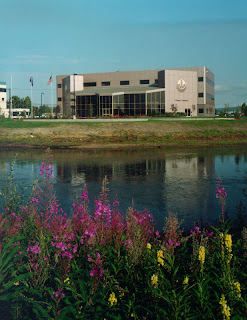Describe the major reasons given for statehood and explain how those reasons are reflected in the Alaska State Constitution.
Quite simply, the reason why Alaskans wanted statehood was because they wanted to have the power to make more decisions regarding the area that they resided in.
Prior to Alaska Statehood in 1959, Alaskan government consisted of a governor appointed by the president and a territorial legislator that had very limited decision making powers.
However, the vast majority of important decisions that affected Alaskan residents, including the passage of laws, management of land and and the ability to impose taxes were made by the Federal government.
 |
| Alaska Constitutional Convention |
The Alaska Constitutional convention took place in Fairbanks during the winter of 1955-1956.
In April of 1956, Alaskans voted on and approved the Alaska Constitution.
On January 3, 1959, Alaska became a state.
The Alaska Constitution is full of provisions that grant more control of Alaska to Alaskan residents.
Three of these provisions are of particular importance to Alaska residents.
 |
| President Eisenhower signing the Alaska Statehood Document |
Second, the state was granted the ability to manage fish and game throughout most of Alaska (Article 8, especially sections 1, 2, 3, 4, 5, 13, 14, 15).
Third, the state was granted the right to impose taxes and receive a large portion of mineral lease sales and royalty payments on state land (Article 8, sections 11, 12; Article 9, sections 1, 5, 6).
Two other more recent aspects of the Alaska Constitution that reflect the state's strong desire for self government are the Alaska Permanent Fund (Article 9, section 15), which provides a dividend check once a year to all residents of Alaska and the Budget Reserve Fund (Article 9, section 17), which is the state's "Rainy Day" fund.
Identify the Alaska Native Regional Corporation in the Area of Alaska where you live. Examine its website and describe its mission and its current business ventures.
 |
| Shareholders of Doyon, Limited |
Mission
"...to continually enhance our position as a financially strong Native corporation in order to promote the economic and social well-being of our shareholders and future shareholders, to strengthen our Native way of life and to protect and enhance our land and resources" (quoted from Doyon, Limited)
Values
- Financially responsible
- Pride and respect in Native ownership
- Socially and culturally responsible
- Commitment to the long-term
- Honesty and integrity
- Commitment to excellence
- Respect for employees
- (Quoted from Doyon, Limited)
 |
| Doyon Plaza |
Facts about the corporation
- It is for-profit
- Composed of more than 18,500 shareholders
- Established in 1971 under the Alaska Native Claims Settlement Act
- Largest private land owner in Alaska
- Has over 12.5 million acres of allocated land
- Headquartered in Fairbanks
- Led by a 13 member board of directors and a team of senior managers
- Currently employs 2,800 individuals in its various businesses
- Businesses include oil and gas services, tourism and government contracting
- Seeks to pursue responsible natural resources development on corporation owned land
- Resource development includes mineral exploration, oil and gas exploration, placer gold, and sand rock and gravel excavation
I really enjoyed studying the process that Alaska went through to become a state. It would have been so exciting to be living in Alaska during this time period.
I must admit that I am not a very political oriented person and most of the information in the government section was new to me.
I also was appalled to find out that the Permanent Fund has significant shares in the Tobacco Industry. I don't understand why ethical principles are not a bigger aspect of the investment decisions made by the Permanent Fund Board.
There was so much important information crammed into this module. I feel like it should be split into two modules for future classes. To compensate, I think that some of the earlier modules from the class could be condensed.
Blog Reviews
Robin gives a nice overview of the pros and cons of World War II on Alaska and a nice overview of the Aleutian Campaign. She also has wonderful pictures.
Christy gives a nice overview of the Aleut evacuation. I also related to her comments about blogging being very time consuming.
Marg has a great section on what was happening in Ketchikan during the war.















